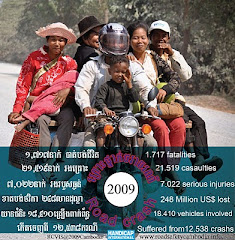One year after its implementation, the helmet rule is still hindered by spotty police enforcement
Photo by: Rick Valenzuela
Cheng Samnang retrieves a checked-in helmet for a shopper Tuesday at Sorya Shopping Centre, where the lot guard said most drivers do not have helmets. One year ago, municipal traffic police began enforcing a law requiring motorbike drivers to wear helmets.LAST month, Chea Mengly, a 29-year-old construction site superviser, was driving his motorbike along Street 63 in Prampi Makara district at night when a car swerved in his direction and cut him off. Minutes before, he had removed his safety helmet to answer his cell phone.
“I had my helmet on at first, but because I had a phone call I took it off,” he said. “I wanted to speed up to pass the car, but instead I crashed into a cyclo. The driver was sleeping in the middle of the street.”
The collision threw him from his bike, and his face hit the pavement when he landed. He fell unconscious, but sustained only minor injuries.
“I got some scratches on my face. I can’t believe that I fell unconscious but was not seriously injured,” he said.
Since then, he has vowed never to go without a helmet when he drives, but not everyone on the roads is so safety-conscious.
As Interior Ministry officials meet this morning to discuss the efficacy of the Land Traffic Law, road safety experts have expressed renewed concern that an amendment adopted a year ago requiring all motorbike drivers to wear helmets has been largely ignored. The amendment calls for violators to be fined 3,000 riels (about US$0.75 ).
Despite the heavy publicity campaigns that were tied to the amendment’s adoption, compliance has been lacklustre, and it has failed to reduce the number of traffic fatalities over the past 12 months, according to government statistics.
The total number of deaths on the Kingdom’s roads climbed from 1,572 in 2008 to 1,654 in 2009, according to Him Yan, the director of the Ministry of Interior’s Public Order Department.
Experts argue that the effectiveness of the helmet amendment has been hindered by spotty enforcement, a trend they say bodes poorly for the prospect of implementing other traffic reforms, such as crackdowns on speeding and drunken driving.
“The key risk factors in injuries are not wearing helmets, drink-driving and speeding, so that’s what [the government has] been focusing on,” said Ryan Duly, a road safety adviser for Handicap International Belgium.
“But a lot more needs to be done. More resources and police are needed long term – the government needs to commit to long-term enforcement and think in years, rather than months. For behaviour to change, that is key.”
The helmet amendment was accompanied by a strong enforcement campaign, at least at first. On January 1, 2009, the day it went into effect, police reported nabbing 120 violators. A few months later, in a speech delivered on May 19 at the Interior Ministry, no less an authority than Prime Minister Hun Sen bemoaned the fact that compliance with the amendment appeared to be on the decline and called for an additional amendment that would empower police to confiscate motorbikes ridden by drivers without helmets.
The attention from government officials seemed to be effective. Helmet use by drivers in the capital – which had already been on the rise, climbing from 9 percent in 2004 to 24 percent in 2008, according to figures from the National Road Safety Commission – skyrocketed, reaching 85 percent in August.
Since then, however, official interest in the amendment has been limited, road safety experts say.
Jeroen Stol, country director for Handicap International Belgium, said the number of drivers wearing helmets had lagged in recent months in particular.
“It looked very promising back in August, but helmet use is decreasing at the moment,” Stol said. “It has to do with enforcement, I believe. People think, ‘I can get away with not wearing a helmet, so why should’I?”
Full force of law not felt
Photo by: Rick Valenzuela
Motorbike riders turn the corner from Kampuchea Krom Boulevard north onto Monivong Boulevard on Tuesday.But Duly said the scorecard system had not yet been implemented, and that he could not predict when it would begin.
Chev Hak, deputy chief of the municipal Traffic Police, said Tuesday that officials were fully committed to enforcing the helmet rule, adding that night deployments of police officers had been in effect sporadically since August 2009 in part for this purpose.
“Enforcement of the law will continue because people will get back into their old habits if we stop,” he said.
Looking ahead, HIB has been lobbying the Ministry of Public Works and Transport to implement an amendment that would increase fines for drivers caught without helmets, establish minimum safety standards for helmets and force passengers to wear them as well.
The September 2009 Ministry of Health Survey found that only 9.8 percent of passengers on national roads and 8.5 percent of passengers in urban areas were wearing helmets. According to figures from the Road Traffic Accident and Victim Information System, passengers accounted for 11 percent of casualties in the first few months of 2009, with children among the most vulnerable.

No comments:
Post a Comment